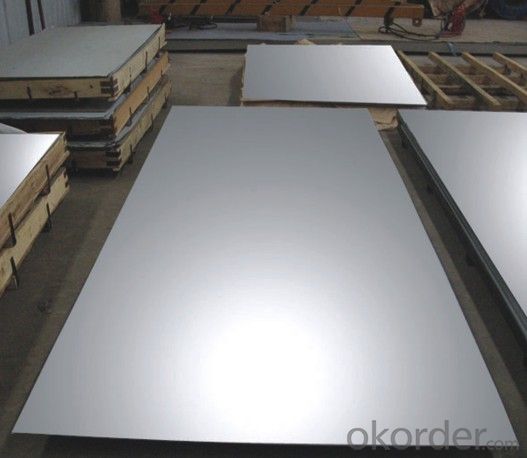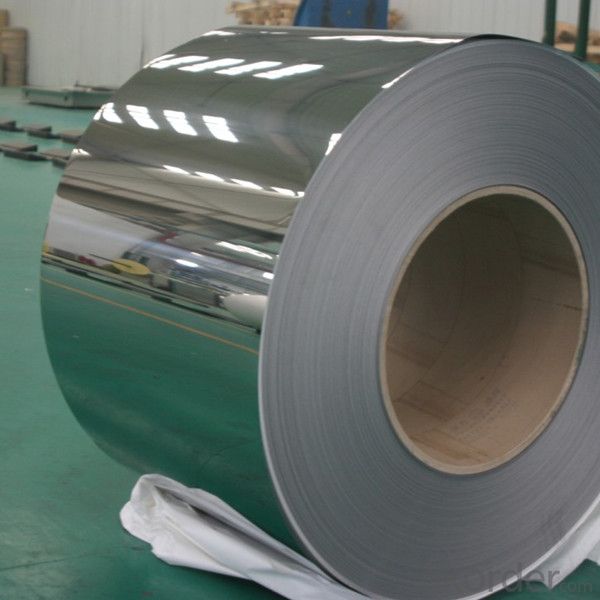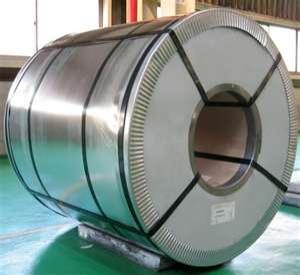Stainless Steel Sheet 4K Surface Treatment 2mmx1220mmx2440mm
- Loading Port:
- Shanghai
- Payment Terms:
- TT OR LC
- Min Order Qty:
- 25 m.t.
- Supply Capability:
- 2500 m.t./month
OKorder Service Pledge
OKorder Financial Service
You Might Also Like
Product Introduction of Stainless Steel Sheet 4K Surface Treatment 2mmx1220mmx2440mm:
Our Stainless Steel products including the stainless steel sheet/plate, stainless steel coil, stainless steel rod/bar, stainless steel angle, stainless steel strip, stainless steel flat, carbon steel products and alloy steel materials. It also can supply the processing of surface, like No.4, BA, HL, SB, 8K, and so on.
Loading Quantity of Stainless Steel Sheet 4K Surface Treatment 2mmx1220mmx2440mm: 25 Tons/20FCL.
Grade of Stainless Steel Sheet 4K Surface Treatment 2mmx1220mmx2440mm: 201, 306, 316 Etc.
Delivery Time of Stainless Steel Sheet 4K Surface Treatment 2mmx1220mmx2440mm: 20 days Per Container.


Application of Stainless Steel Sheet 4K Surface Treatment 2mmx1220mmx2440mm:
| Finish | Thickness | Characteristics | Applications |
| No. 1 | 3.0mm~50.0mm | Finished by hot-rolling, annealing and pickling, characterized by white pickled surface | Chemical industry equipment, Industrial tanks |
| No. 2B | 0.3mm~6.0mm | Finished by heat treatment, pickling after cold rolling, followed by skin pass line to be more brighter and smooth surface | General Application Medical Instruments,Tableware |
| No. BA (Bright Annealed) | 0.5mm~2.0mm | Bright heat treatment after cold rolling | Kitchen utensil, kitchen ware,architectural purpose |
| No. 4 | 0.4mm~3.0mm | Polishing with No. 150 to No.180 mesh abrasivesThe most popular finishes | Milk & Food processing acilities, Hospital Equipment, Bath-tub |
| HL(Hair Line) | 0.4mm~3.0mm | Finished by continuous linear polishing | Architectural purposes, escalators, kitchen ware vehicles |
FAQ
Q: CAN YOU PROVIDE MILL TEST CERTIFICATE?
A: YES! Mill Test Certificate for Stainless Steel Sheet 4K Surface Treatment 2mmx1220mmx2440mm are available.
Q: CAN YOU MAKE DDQ (DEEP DRAWING QUALITY)?
A: YES. Our material has been widely used for producing Stainless Steel Pots and Stainless Steel Sinks, which have strict request for good deep drawing quality.
Q: HOW TO GET A SAMPLE?
A: FREE Stainless Steel Sheet 4K Surface Treatment 2mmx1220mmx2440mm are available for your checking and testing. And to get free samples, you need to send us you detailed receiving address (including post code) and your DHL/FedEx/UPS account for collecting samples, courier cost will be paid in your side.
- Q:What are the benefits of using brushed stainless steel sheets in hospitality design?
- Using brushed stainless steel sheets in hospitality design offers several benefits. Firstly, brushed stainless steel has a sleek and modern appearance that adds a touch of elegance to any space, making it a popular choice in the hospitality industry. Additionally, stainless steel is highly durable and resistant to corrosion, ensuring that it can withstand the demands of a busy hospitality environment. It is also easy to clean and maintain, making it a practical choice for surfaces that require frequent sanitation. Furthermore, brushed stainless steel sheets are versatile and can be used in various applications, from countertops and backsplashes to furniture and fixtures, allowing designers to create cohesive and visually appealing spaces.
- Q:What are the different types of stainless steel sheet edges?
- Stainless steel sheets come in three main types of edges: mill edge, slit edge, and deburred edge. 1. The mill edge is the most common type and is produced during manufacturing. It has a rough, unfinished edge that is typically straight and perpendicular to the sheet's surface. It is suitable for applications where a smooth edge is not necessary. 2. Slit edge sheets are created by cutting large rolls of stainless steel into narrower widths. These edges are smoother and more precise compared to the mill edge. They are commonly used in applications that require a polished and precise edge, such as architectural finishes or fabrication processes. 3. A deburred edge is achieved by removing any sharp or rough edges from the stainless steel sheet. This is done to improve safety during handling or installation. Deburring can be done through grinding, sanding, or using specialized tools. The resulting edge is smooth and free from burrs or sharp protrusions. It's important to consider the specific application and requirements when choosing the edge type for a stainless steel sheet. Each type has its own advantages and limitations, and factors like aesthetics, functionality, and safety should be taken into account when selecting the appropriate edge for a project.
- Q:What are the different types of embossed patterns available for stainless steel sheets?
- Stainless steel sheets offer a variety of embossed patterns to choose from. Some of the commonly seen options are as follows: 1. Diamond Pattern: This pattern showcases a series of diamond-shaped raised protrusions on the sheet's surface. It is a popular choice as it adds visual interest and texture to various applications. 2. Linen Pattern: The linen pattern features parallel lines that create a textured appearance resembling linen fabric. Architects and interior designers often utilize this pattern due to its unique aesthetic. 3. Squares Pattern: As the name suggests, this design consists of square-shaped raised protrusions on the stainless steel sheet. It provides a clean and modern look, suitable for a wide range of applications. 4. Leather Pattern: The leather pattern imitates the texture and appearance of leather, adding elegance and sophistication to stainless steel sheets. It is a favored choice for decorative purposes. 5. Moire Pattern: The moire pattern creates a wavy or rippled design, resulting in an optical illusion effect. It adds a dynamic visual element to stainless steel sheets, making them stand out. 6. Checkerplate Pattern: This pattern consists of raised squares or rectangles arranged in a checkered pattern. Its high slip resistance makes it ideal for applications where safety is crucial, such as stairs or ramps. These examples represent only a fraction of the embossed patterns available for stainless steel sheets. The choice of pattern depends on aesthetic preference, functionality, and specific application requirements. Whether for architectural, interior design, or industrial purposes, there is a wide range of embossed patterns to cater to various needs.
- Q:What are the different types of stainless steel sheet edges available?
- There are several different types of stainless steel sheet edges available, each offering its own unique advantages and characteristics. 1. Mill Edge: This is the standard edge finish produced during the manufacturing process. It has a straight, sharp edge with no additional treatment or finishing. Mill edge stainless steel sheets are commonly used in industrial applications where aesthetics are not a priority. 2. Slit Edge: Slit edge stainless steel sheets are created by cutting the sheet along its length, resulting in a slightly rounded edge. This type of edge is commonly used in applications where safety is a concern, as it reduces the risk of sharp edges causing injury. 3. Sheared Edge: Sheared edge stainless steel sheets are created by cutting the sheet along its width using shearing blades. This process produces a clean, straight edge without any additional finishing. Sheared edge sheets are often used in applications where precise dimensions are required. 4. Deburred Edge: Deburred edge stainless steel sheets have gone through a process to remove any sharp or rough edges, resulting in a smooth and safe edge finish. Deburring is often done using abrasive materials or specialized machinery. These sheets are commonly used in applications where safety and aesthetic appearance are both important. 5. Rolled Edge: Rolled edge stainless steel sheets have a curved or rounded edge, created by rolling the sheet during the manufacturing process. This edge type is commonly used in applications where a smoother, more finished appearance is desired. Rolled edge sheets are also easier to handle and less likely to cause injury during installation. Overall, the choice of stainless steel sheet edge depends on the specific requirements of the application, including safety concerns, aesthetic preferences, and dimensional accuracy.
- Q:Are stainless steel sheets suitable for automotive applications?
- Yes, stainless steel sheets are suitable for automotive applications. They are widely used in the automotive industry due to their durability, corrosion resistance, and high strength-to-weight ratio. Stainless steel sheets provide excellent protection against rust and can withstand harsh conditions, making them ideal for various automotive components such as exhaust systems, body panels, and structural parts.
- Q:How do stainless steel sheets compare to other materials, such as aluminum or carbon steel?
- Stainless steel sheets offer distinct advantages when compared to other materials like aluminum or carbon steel. They have superior corrosion resistance, making them ideal for applications in harsh environments or industries like food processing. Stainless steel sheets also possess high heat resistance, strength, and durability, making them suitable for various structural and industrial purposes. While aluminum is lightweight and has good conductivity, it lacks the same level of strength and corrosion resistance. Carbon steel, on the other hand, is strong but more susceptible to corrosion. Overall, stainless steel sheets provide a balance of strength, durability, and corrosion resistance, making them a preferred choice in many industries.
- Q:Are stainless steel sheets resistant to heat and high temperatures?
- Yes, stainless steel sheets are highly resistant to heat and high temperatures. They can withstand extreme temperatures without warping, melting, or losing their structural integrity.
- Q:What is the weldability of stainless steel sheets?
- The weldability of stainless steel sheets is typically regarded as favorable due to the high percentage of chromium present in stainless steel. This chromium forms a passive oxide layer on the metal's surface, which contributes to exceptional corrosion resistance and the prevention of heat-affected zones during welding. Nevertheless, the weldability of stainless steel can differ based on the specific grade and thickness of the sheets. Austenitic stainless steels, such as 304 and 316, are known for their high weldability and can be easily joined using various welding techniques like TIG and MIG. Conversely, martensitic or duplex stainless steels may possess lower weldability due to elevated carbon content or distinct microstructures. These grades may necessitate preheating and post-weld heat treatment to prevent cracking and maintain desired mechanical properties. Moreover, the thickness of stainless steel sheets can impact weldability. Thicker sheets may require increased heat input and specialized welding procedures to ensure proper fusion and prevent distortion. Overall, stainless steel sheets are generally considered to possess good weldability. However, it is crucial to consider the specific grade and thickness of the sheets, as well as the required welding techniques and procedures, to achieve optimal results. Seeking professional guidance and expertise in stainless steel welding is recommended to ensure successful and long-lasting welds.
- Q:Can stainless steel sheets be used for heat transfer applications?
- Yes, stainless steel sheets can be used for heat transfer applications. Stainless steel has excellent thermal conductivity, making it suitable for transferring heat efficiently between two surfaces or mediums. It is commonly used in heat exchangers, cookware, and other applications where heat transfer is essential.
- Q:What are the benefits of using laser-cut stainless steel sheets?
- There are several benefits of using laser-cut stainless steel sheets: 1. Precision and accuracy: Laser cutting offers high precision and accuracy, resulting in clean and precise cuts on stainless steel sheets. This ensures that the desired design or shape is achieved with minimal errors or imperfections. 2. Versatility: Laser cutting technology allows for the cutting of intricate and complex designs on stainless steel sheets. This versatility makes it suitable for a wide range of applications, including architectural, industrial, automotive, and decorative purposes. 3. Time and cost efficiency: Laser cutting stainless steel sheets is a relatively quick and efficient process. It requires less setup time and can be automated, reducing labor costs and increasing productivity. Additionally, laser cutting eliminates the need for additional finishing processes, saving both time and money. 4. Clean and smooth edges: Laser cutting provides clean and smooth edges on stainless steel sheets, eliminating the need for additional filing or grinding. This results in a high-quality finish, enhancing the overall aesthetics of the final product. 5. Minimal material wastage: Laser cutting is a non-contact process, which means there is no physical force applied to the stainless steel sheets. This results in minimal material wastage, as the laser beam precisely cuts through the targeted areas without damaging the surrounding material. 6. Reduced risk of distortion: Traditional cutting methods, such as plasma cutting or shearing, can cause distortion or warping of the stainless steel sheets. Laser cutting, on the other hand, produces minimal heat-affected zones, reducing the risk of distortion and ensuring dimensional accuracy. 7. Enhanced design possibilities: Laser cutting enables the creation of intricate designs and patterns on stainless steel sheets that may not be possible with other cutting methods. This opens up a world of design possibilities, allowing for unique and visually appealing products. Overall, the benefits of using laser-cut stainless steel sheets include precision, versatility, time and cost efficiency, clean edges, minimal material wastage, reduced risk of distortion, and enhanced design possibilities. These advantages make laser cutting an attractive choice for various industries and applications.
1. Manufacturer Overview |
|
|---|---|
| Location | |
| Year Established | |
| Annual Output Value | |
| Main Markets | |
| Company Certifications | |
2. Manufacturer Certificates |
|
|---|---|
| a) Certification Name | |
| Range | |
| Reference | |
| Validity Period | |
3. Manufacturer Capability |
|
|---|---|
| a)Trade Capacity | |
| Nearest Port | |
| Export Percentage | |
| No.of Employees in Trade Department | |
| Language Spoken: | |
| b)Factory Information | |
| Factory Size: | |
| No. of Production Lines | |
| Contract Manufacturing | |
| Product Price Range | |
Send your message to us
Stainless Steel Sheet 4K Surface Treatment 2mmx1220mmx2440mm
- Loading Port:
- Shanghai
- Payment Terms:
- TT OR LC
- Min Order Qty:
- 25 m.t.
- Supply Capability:
- 2500 m.t./month
OKorder Service Pledge
OKorder Financial Service
Similar products
New products
Hot products
Related keywords






























